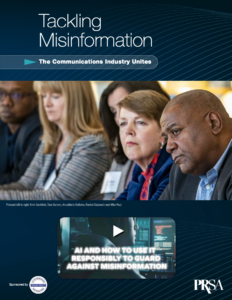Download a copy of “Tackling Misinformation: The Communications Industry Unites” here. Comms pros can find more resources on the topic here.
This is a critical year in the ongoing fight against the proliferation of misinformation and disinformation.
In 2024, more than 50 countries worldwide are in election cycles. According to the World Economic Forum’s Global Risks Report 2024, disinformation is considered the world’s top risk in the next two years and the fifth global risk in the next 10 years.
In late 2023, PRSA convened a group of nearly two dozen communications executives, journalists, and academics to discuss misinformation and disinformation. Further discussions inspired a first-of-its-kind guide titled “Tackling Misinformation: The Communications Industry Unites,” a collection of perspectives, data points, analyses and resources that PRSA released on April 8.
The guide, produced in association with Issuer Direct, is designed to educate communicators and PR practitioners, and help them navigate the growing problem of misinformation, disinformation and malinformation.
“We knew it was time to take what we had been talking about to the next level,” said Ray Day, APR, vice chair of Stagwell, and PRSA’s 2024 chair-elect, who helped spearhead the project.
As the 32-page document notes, misinformation has contributed significantly to the country’s polarization and lack of civility during a time of deep division. The communications profession “must help preserve democracy by working against misinformation, disinformation, and malinformation.”
In an interview with PRSA Publications Director John Elsasser, Day pointed out that falsehoods are nothing new.
“Human behavior contributes to misinformation,” he said. “Spreading lies, spreading false information, either intentionally or unintentionally, has been happening for as long as people have been communicating.”
What’s new, he said, is the speed at which falsehoods can now reach large audiences, “in part due to technology that’s available to all of us, particularly generative AI. Misinformation is affecting our lives.”
A movement to change human behavior
“There’s so much information coming at us, much more than ever before,” Day said. “People are living in echo chambers, just getting one point of view and biased information. We need more critical thinking, more media literacy. We need to be more discerning, more skeptical, to ask more questions. We need to be able to call people out in a respectable, non-threatening way and say, ‘Maybe you need to go back and check your sources.’”
A goal of the guide is to “tackle the problem of misinformation without undermining civil discourse,” Day said. “Our vision is to create a movement that changes human behavior, not dissimilar to the Truth Initiative that educated consumers about the harms of tobacco.”
To that end, “All of us can become better at pushing back on misinformation,” he said. “We need to be better equipped to self-police and self-correct misinformation and disinformation when we see it. To create a movement, we have to change our own behaviors.”
After studying sources of misinformation, the group learned that “bad actors are oftentimes out-communicating us,” he said. “They’re doing communications better than we do. We need to get back to the basics of communications.”
Day said that, by studying the tactics of those who spread disinformation, communicators can out-communicate them. “We need to work together like never before.”
Watch the full video interview between Ray Day, APR, and John Elsasser here.








